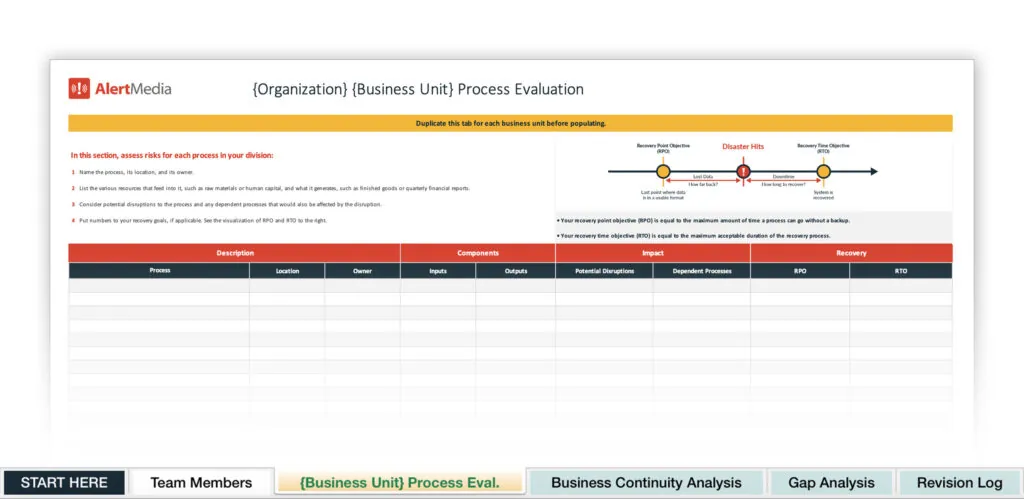
What Is a Business Impact Analysis (BIA)? How to Conduct Your Own in 4 Steps
You probably have an idea of the kinds of threats your business might face, but how carefully have you considered the full range of potential damage? That’s where BIA comes in.

When Memorial Health System became the victim of a “hive”-style cyberattack that infected all their servers and computers, they ran into a cascade of problems. On The Employee Safety Podcast, we spoke with Lori Price, the Emergency Management Coordinator at Memorial about the importance of understanding how business functions are interconnected. As a result of the attack, critical medical information systems—such as diagnostic machines, including MRIs—could not send out results. Digital records became useless, and old paper backups had to come out of storage. To top it off, vendors’ servers refused to communicate with Memorial’s contaminated ones, further hampering operations. Payroll was impacted; even the cafeteria cash registers lost internet connectivity.
—Lori Price, Emergency Management Coordinator, Memorial Health System
Since they had already analyzed and prepared for the ways in which one cybersecurity problem can quickly become many, they were able to adapt to this disruption and continue offering their lifesaving care to patients. But any business that hasn’t performed proper analysis would have been far worse off. While we can’t necessarily prevent these events from occurring, we can better understand, and thus better limit, their impact. How? With a business impact analysis.
Business Impact Analysis Template
Know how to prioritize recovery
A business impact analysis is one of the most important elements of any emergency response strategy. It helps organizations define the critical processes and operations they must recover quickly if a disaster strikes. In a true emergency, it can be hard to know where to start. The downtime resulting from a widespread utility outage or IT failure, for example, can have far-reaching effects across many mission-critical business processes. With a business impact analysis, you can gain clarity on how to prioritize your recovery efforts to minimize the losses from a major business disruption.
In this blog post, we’ll explore what a business impact analysis is, why every organization needs one, and how you can conduct this assessment to inform your disaster recovery, business continuity, and emergency response plans. You can also use this free template download to simplify your BIA process.
Preview of AlertMedia’s Business Impact Analysis Template spreadsheet
What Is a Business Impact Analysis (BIA)?
A business impact analysis or business impact assessment (BIA) is a structured process that organizations use to determine how critical various business activities and resources are to continuing normal business operations.
The various organs of a business have different goals, dependencies, and resources that determine how they function. A business impact analysis… well, analyzes these organs and determines what happens to the rest of the business when one of them is disrupted or fails.
With these insights, businesses can develop business continuity and disaster recovery strategies to limit potential losses.
What is BIA vs. risk assessment?
While a risk or threat assessment identifies the types of threats a business is most likely to face, a BIA looks at the business consequences. For a BIA, the cause of the business disruption is less important. It could be an accident, natural disaster, cyberattack, or something else. A BIA only considers the business impact of the disruption, prioritizes resources, and determines the best approach to disaster recovery.
Unlike a business threat assessment, BIAs are concerned with the results of disruptions rather than the causes of those problems—though both processes complement your business continuity strategy and work well in tandem.
A BIA identifies the financial and operational impacts resulting from the disruption of business functions and processes. Operational impact analysis may include:
- Lost or delayed revenue
- Increased expenses
- Regulatory fines and legal fees
- Contractual penalties
- Brand and reputational damage
- Customer churn or dissatisfaction
Of course, the business impact depends greatly on the duration and timing of the disruption. A 30-second power outage will have less impact than a 24-hour IT outage. A fire in a remote and partially empty warehouse will be less of an interruption than a fire in an active manufacturing facility. For a retailer experiencing an eCommerce site outage, the impact is obviously greater if it occurs during a big sale or seasonal event like Black Friday compared to a slower period.
By analyzing different possible disruptions and their effect on critical business processes, a business impact analysis prepares organizations to handle any emergency more readily. A BIA is also a critical step in developing an effective business continuity plan (BCP).
How Business Impact Assessments Fit Into Business Continuity Planning

A BIA lays the foundation for your business continuity plan. It ensures your organization has a clear plan of action and the resources required to recover from critical events efficiently and with minimal disruption.
With the ability to recover quicker, organizations can reduce costs, optimize employee productivity, and maintain customer trust. A business impact analysis gives business leaders more confidence in their decisions when responding to critical events. It also enables organizations to determine—well in advance of a crisis—what mitigation strategies and tools they can utilize so they’re not left scrambling when disaster strikes.
From severe weather and natural disasters to cyberattacks and workplace accidents, all businesses will experience a disruptive event sooner or later. To mitigate the bottom-line impact of these threats, every business should perform a business impact analysis as part of their business continuity and disaster recovery planning efforts.
4 Steps to Using a Business Impact Analysis Template
There is no one-size-fits-all rulebook for conducting a business impact analysis; every company has unique methods and organizational structures. However, some common elements should go into every BIA, and a great way to start is with a free BIA template like this one.
Here are four essential steps in any organization’s BIA process:
Step #1: Build your business impact analysis project team
Before conducting your business impact analysis, you must assemble the project team. A BIA team should include the following roles:
- Project Leader: Primary contact responsible for conducting a successful business impact analysis.
- Executive Sponsor: Executive champion responsible for providing strategic input and guidance.
- Business Process Owners: Representatives from different business units, such as IT and Finance, who will provide insights into relevant business processes, aid decision-making, and help implement BIA recommendations.
—Erica Reed, Business Resilience Analyst, Macy’s
Here’s what your business impact analysis project team may look like, along with each team member’s responsibilities:
Responsibilities: Provide overall project management responsibility, working with business owners to deliver the business impact analysis.
Responsibilities: Provide strategic input, support problem resolution, and give executive signoff on critical activities.
Responsibilities: Analyze the IT applications and software systems to determine if current IT disaster recovery (DR) arrangements enable recovery of these within specific recovery time objectives (RTOs).
Responsibilities: Consider regulatory requirements, contractual obligations, fines, and legal liabilities that may come up during business disruptions.
Responsibilities: Determine the key business risks, define the risk threshold, and help develop the impact parameters.
Responsibilities: Supply financial data and advice on direct and indirect financial impacts.
Responsibilities: Provide information on critical supply chain dependencies, production-related activities, and operational impacts.
Responsibilities: Consider duty of care obligations, compliance, and employee health and safety.
Responsibilities: Supply information on facilities, utilities, alternative recovery work locations, etc.
Step #2: Gather and evaluate business process information
With your all-star team assembled, it’s time to roll up your sleeves. As you begin to gather information, send a BIA questionnaire to survey managers and others within the business. You’ll also want to personally interview those with detailed knowledge of how the business manufactures its products or provides its services. With these insights from business process owners and key stakeholders, you’ll be able to understand the potential consequences better if a particular business function or process is interrupted.
In your BIA interviews and surveys, you’ll want to capture information about various business processes such as:
- Name of the process
- Where it is performed
- Inputs and outputs
- Resources and tools used
- Any process interdependencies
- Types of impact
- Impact of changes/disruptions (financial, operational, regulatory, etc.)
- How the timing and duration of a given disruption affect its impact
Once you have collected all the information needed about each business process, the impact analysis can begin. Consider these five questions:
- Which functions and processes are most important to business continuity?
- What resources (people and technology) does each process need?
- What is the recovery timeline for bringing each process back to normal operation?
- What is the recovery point objective (RPO)? In other words, what is the timeframe for when services/data need to be restored?
- What contingency plans should be in place to mitigate the amount of time an emergency disrupts operations?
Step #3: Prepare a BIA report to aid business continuity and disaster recovery
Once the information gathering and analysis phase is complete, it’s time to prepare a business impact analysis report. This report will allow you to communicate your findings and recommendations to senior management via an executive summary, as well as guide the development of your business continuity plan with evidence-based analysis to guide your efforts.
The BIA report should document the potential impacts of disruption of business functions and processes. It will also provide the order of response priorities for restoring normal business operations. Business processes with the greatest financial and operational impacts should be restored first and given an appropriate resource allocation to mitigate downtime.
Your recovery process should also account for potential risks, such as financial loss resulting from a failure to hit recovery time objectives. For example, if your business is likely to sustain a significant impact from a failure to restore critical systems quickly or SLAs with third-party providers are not sufficient to meet recovery time objectives, those vulnerabilities should be outlined in the BIA report, along with recommendations to remediate the issue.
Step #4: Implement recommendations to address continuity vulnerabilities
Once your team has conducted the business impact assessment and outlined disaster recovery strategies, the final step is to implement the recommendations from the business impact analysis report. Buy-in and support from your executive sponsor and business owners are critical to ensuring recommendations are implemented across each of the critical business functions identified.
Also, be sure to regularly revisit your business impact analysis to update it as new processes are implemented, the organization’s structure is reshuffled, or available resources change. Your business isn’t static—and neither is a business impact analysis. With your organization constantly growing and evolving, the BIA should be regularly reviewed and modified as needed to ensure it’s still valid.
Adopting Mitigation Tools and Strategies
Once the BIA is complete, business continuity and disaster recovery leaders can use it to help implement mitigation strategies and tools to reduce the impact of various threats. And one such tool is a modern emergency communication solution.
During disruptive events, communication is a lifeline. Being able to relay information and instructions to employees is critical to a fast, efficient emergency response. Emergency communication systems with integrated threat intelligence allow businesses to more rapidly identify threats, visualize the people and locations that are impacted, and facilitate an organized response using multichannel communication—all from a single platform.
Threat intelligence capabilities allow you to recognize critical situations before they happen, giving you the benefit of alerting and organizing your audience in advance. It provides the organization with “always-on” monitoring to identify potentially disruptive incidents as quickly as possible. This helps mitigate losses by improving readiness and accelerating response times.
BIA Means Constant Vigilance
Regarding emergency preparedness and your disaster recovery plan, speed is everything. How quickly can you identify potential threats? How quickly can you communicate with employees? How long does it take you to restore business operations?
Your organization’s ability to rapidly respond and recover from business disruptions is directly related to the effectiveness of your business continuity management. And every effective business continuity plan is rooted in business impact analysis. The ISO 22301 standard lays out a framework for organizations to plan, implement, and maintain a business continuity management system (BCBS) to minimize disruptions.
While there are many ways organizations can improve emergency preparedness—from developing comprehensive preparedness plans to regularly conducting tabletop exercises—the world’s most resilient organizations are constantly looking for ways to accelerate how they detect, validate, and respond to any threat to their people or business. With a business impact analysis supported by modern threat intelligence and emergency communication technology, organizations can maintain organizational resilience, protect the bottom line, and keep business operations running as smoothly as possible during unexpected disruptions.





